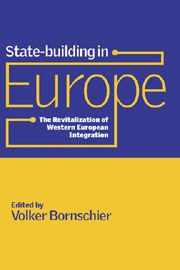Book contents
- Frontmatter
- Contents
- List of figures and tables
- List of contributors
- Preface
- Acknowledgements
- Part I State-building and Political Entrepreneurship
- Part II The Core Elements in Recasting the European Bargain
- 3 The origins of the Single Market
- 4 Esprit and technology corporatism
- 5 EC regional policy: monetary lubricant for economic integration?
- 6 EC social policy: the defeat of the Delorist project
- Part III Conclusions beyond the Single European Act of 1986
- Appendix List of interview partners
- Bibliography
- Index
3 - The origins of the Single Market
Published online by Cambridge University Press: 10 October 2009
- Frontmatter
- Contents
- List of figures and tables
- List of contributors
- Preface
- Acknowledgements
- Part I State-building and Political Entrepreneurship
- Part II The Core Elements in Recasting the European Bargain
- 3 The origins of the Single Market
- 4 Esprit and technology corporatism
- 5 EC regional policy: monetary lubricant for economic integration?
- 6 EC social policy: the defeat of the Delorist project
- Part III Conclusions beyond the Single European Act of 1986
- Appendix List of interview partners
- Bibliography
- Index
Summary
Introduction
The Single European Act was formally approved by the European Council in February 1986. When Maastricht hit the headlines in the early 1990s, the Single European Act instantly became history. However, it was the Single Market programme – the main content of the Single European Act – and the years of preparation leading up to it that really gave new momentum to European integration after the ‘Eurosclerosis’ of the 1970s.
The process that led to the Single European Act was never publicly discussed. The architects and initiators of the Single Market have not become household names; however, it is these protagonists and their efforts that are the subject of this chapter.
The thesis guiding our empirical research on the new momentum in European integration suggests a collaboration between the Commission of the European Communities and European transnational business represented by the European Roundtable of Industrialists, as stated in more detail in chapter 1. This explanation contrasts with other theories, which have placed the governments of the three main European Community member states – Germany, France and the United Kingdom – in the foreground. The empirical evidence to support our explanation was gathered by analysing various articles and papers and the official documents of the European Communities and from interviews with witnesses and protagonists of the integration process.
Three main points from the contents of the Single European Act must be emphasized. First, Article 13, which provides an amendment to Article 8a of the EEC Treaty, requests the institutions of the Community ‘to adopt measures with the aim of progressively establishing the internal market over a period expiring on 31 December 1992.
- Type
- Chapter
- Information
- State-building in EuropeThe Revitalization of Western European Integration, pp. 75 - 92Publisher: Cambridge University PressPrint publication year: 2000
- 2
- Cited by



